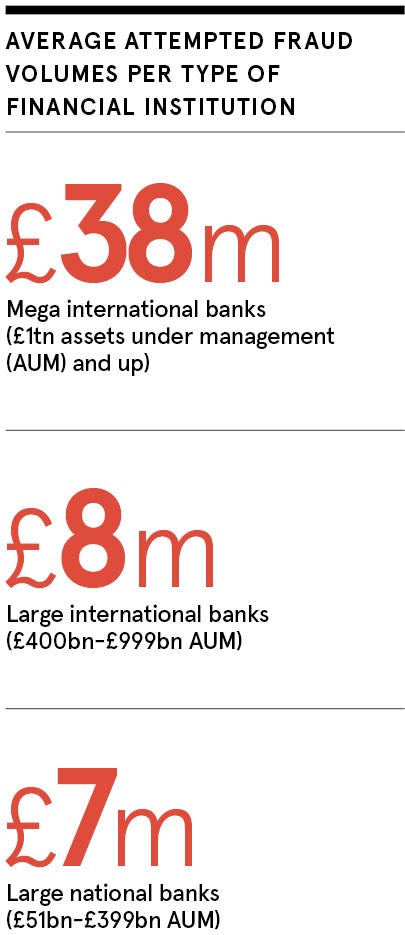
Criminals move quickly. With new ways of engaging with financial institutions, from digital banking to chatbots, fraudsters find new attack vectors to harm customers. Fraud volumes have continued to increase in recent years.
Since the beginning of the pandemic, application fraud for new account openings has increased by over 134%. By 2023, synthetic identity fraud is forecast to make up over $1 billion of annual fraud losses, according to research by Aite Group.
Today’s digital channels naturally produce more data. As open banking brings even more players into the payments ecosystem, the pressure increases to verify and authenticate legitimate activity. Fraudsters adapt and are becoming more organised, recognising the need to become more technically sophisticated.
Fraud and financial crime programmes need to understand the new normal and adapt quickly.
In this “new normal”, customers are unlikely to migrate back to physical branches. It is expected that 85% of consumers who have used digital platforms for financial services will favour this form of interaction post-pandemic, according to enterprise fraud management solutions provider NICE Actimize.
To truly protect customers and safeguard company assets, financial institutions have begun to take a holistic approach to fraud prevention
This shifting behaviour is both an indication of the digital model of the future and a catalyst for digital growth across the financial services industry. It is also, unfortunately, an opportunity for fraudsters to profit from escalating online activity. It focuses them on finding weaknesses in existing fraud prevention systems. Application or new account fraud, in which fraudsters are using stolen or synthetic identities for criminal activity, has emerged as one of the greatest threats to financial institutions.
“The proliferation of sophisticated fraud schemes that utilise stolen and synthetic ID has intensified with the need of financial services organisations to adopt frictionless, digital-only new account opening processes,” says Craig Costigan, CEO of NICE Actimize.
Traditional fraud prevention and identity verification solutions have fallen short in addressing complex fraud manifesting from stolen or synthetic identities. With fraudsters adapting their tactics, financial institutions will require advanced analytics and real-time detection to improve their digital services and continuously address diversifying, complex and well-orchestrated fraud schemes.
Accelerated digitalisation requires automation
The accelerated digitalisation of the last decade – and particularly the last year amidst the pandemic – has left risk and compliance teams challenged by growing regulatory scrutiny and expectations. Along with shifting consumer behaviours, this has necessitated a dramatic change from slow manual-intensive processes towards more intelligent automation. Consumers want instant, accurate, convenient experiences, and financial services organisations must be able to meet their customers’ expectations for immediacy and safety, while adhering to relevant regulation.
Real-time responsiveness to a quickly evolving fraud market is essential to identify and mitigate new forms of fraud before they result in reputational, financial and customer satisfaction damage. To achieve this, financial institutions have realised the need to transition from rules-based fraud detection to next-generation, advanced analytics that adapt in real-time, preventing fraud before the customer is impacted.
When a customer begins a relationship with a financial institution, the company creates an initial profile. Customer behaviours must be continuously captured and analysed so the profile remains accurate. Behavioural analytics enables organisations to understand customer patterns and discover deviations in all activities across all channels. Organisations have also realised that only by understanding normal behaviour can they accurately interdict what is abnormal and anomalous. Advanced analytics powered by real-time data streams captures and analyses behaviours and activities pertaining to financial crime, stopping fraud before a loss occurs.
With the financial services industry experiencing acute disruption due to accelerated digitalisation, data breaches, a surge in contactless payments, and an intensifying threat landscape, companies must capitalise on the benefits of artificial intelligence to strengthen fraud prevention strategies. AI is a critical force to effectively fight and prevent financial crime while remaining competitive in the market and delivering a seamless and trusted customer experience.
Financial institutions are data-rich, making it an ideal domain for the strategic application of AI and machine learning to empower more responsive, collaborative and sophisticated approaches in the fight against pervasive fraud. An agile, end-to-end fraud prevention platform with intelligence from AI enables financial institutions to not only stop fraud faster, but also before it even starts, preventing the impact to the customer.
The continuous self-learning provided by comprehensive, advanced analytics-based solutions ultimately eliminates fragmented approaches to fraud prevention and transforms fraud operations to efficiently, holistically and proactively mitigate fraud, rapidly stopping a range of attacks.

Protecting the customer lifecycle
Fraud can manifest itself at any time across the customer journey. To truly protect customers and safeguard company assets, financial institutions have begun to take a holistic approach to fraud prevention, beginning at the point of application and continuing throughout the entire relationship. At each point in the customer lifecycle, unique threats may manifest themselves.
What will fuel even greater accuracy and effectiveness in fighting financial crime is the winning combination of AI, analytics and data intelligence.
Financial institutions that create a more fully integrated, data-driven and analytical approach to customer lifecycle risk management, with holistic fraud prevention within a single platform, will be able to more effectively balance the expectations for a seamless customer experience against the huge pressure to build better defences against financial crimes.
Fraud management is more than just stopping fraud loss. Fraud management is about balancing the risk of fraud against the need to exceed customer expectations at every touch point in the customer journey.
For more information, visit www.niceactimize.com
Sponsored by

Criminals move quickly. With new ways of engaging with financial institutions, from digital banking to chatbots, fraudsters find new attack vectors to harm customers. Fraud volumes have continued to increase in recent years.
Since the beginning of the pandemic, application fraud for new account openings has increased by over 134%. By 2023, synthetic identity fraud is forecast to make up over $1 billion of annual fraud losses, according to research by Aite Group.
Today’s digital channels naturally produce more data. As open banking brings even more players into the payments ecosystem, the pressure increases to verify and authenticate legitimate activity. Fraudsters adapt and are becoming more organised, recognising the need to become more technically sophisticated.

